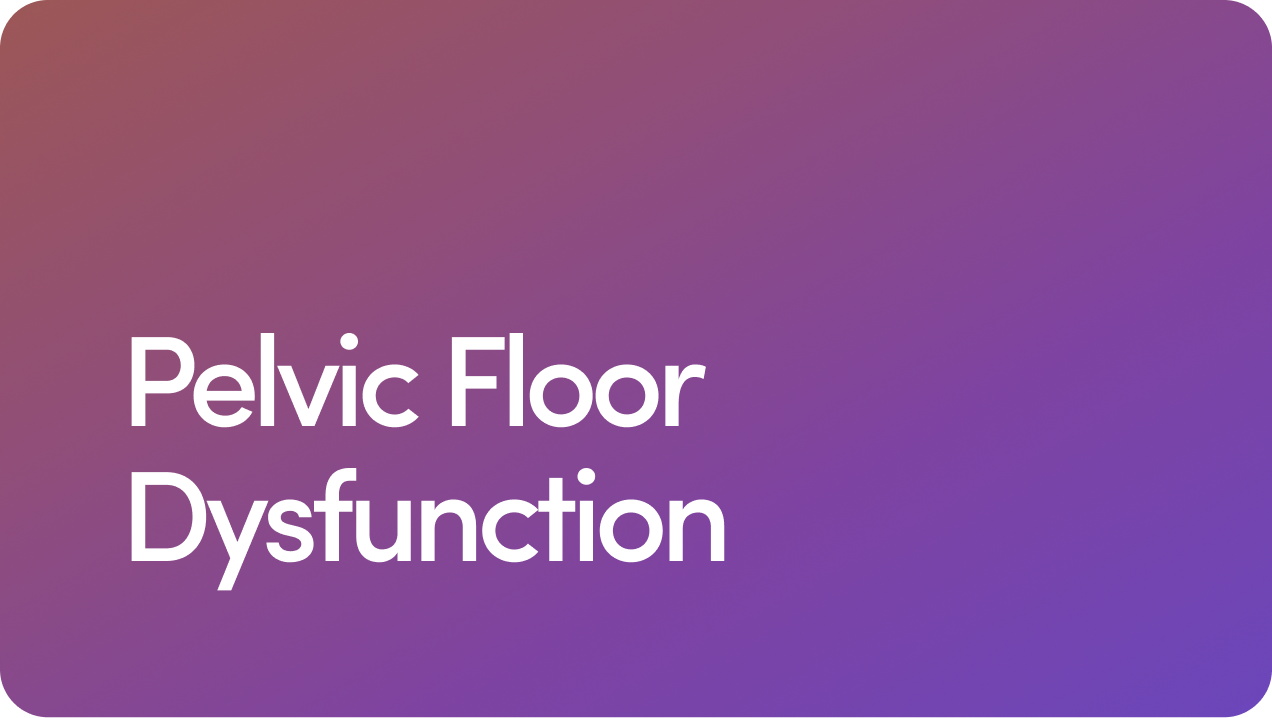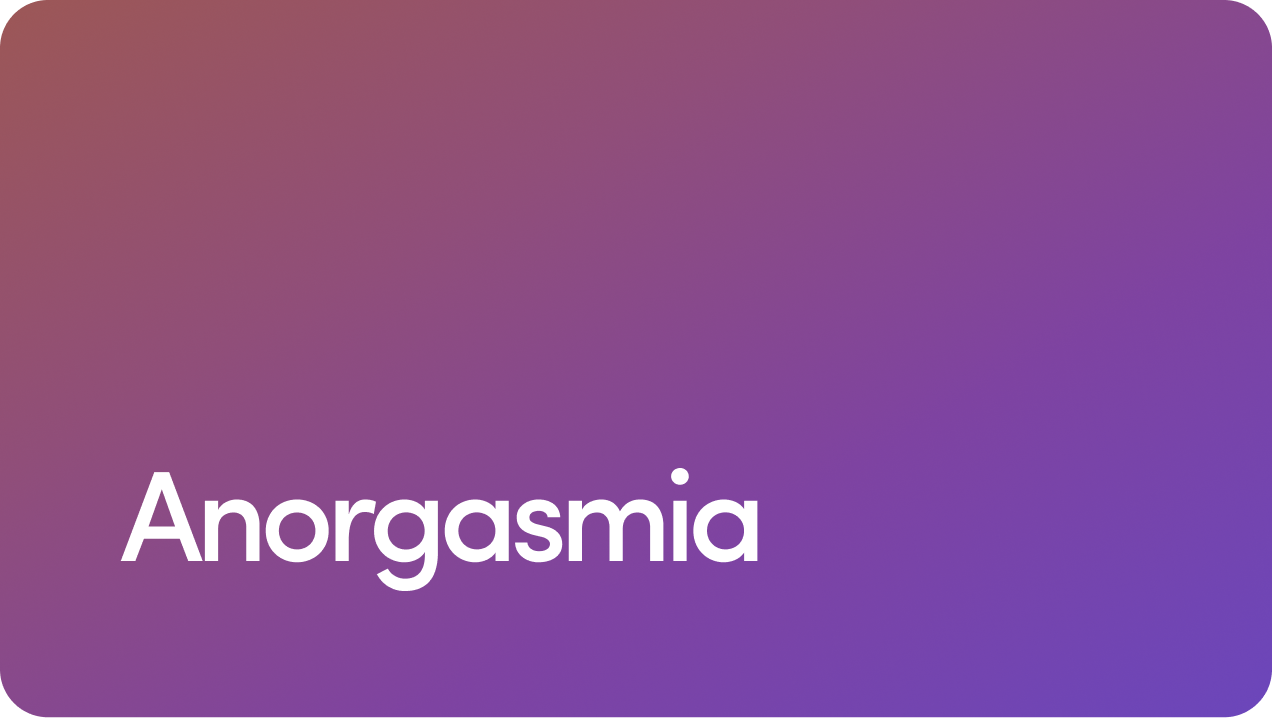Hypersexuality

If you’re feeling isolated or frustrated and searching terms like “hypersexual meaning,” know that you aren’t alone.
Overview
If you’re feeling isolated or frustrated and searching terms like “hypersexual meaning,” know that you aren’t alone. Hypersexuality is a complex condition and getting diagnosed can be an involved process, but thankfully, there are treatment options that can help ensure sex remains a part of your life without negatively impacting your day-to-day, mental health, or relationships.
What Is Hypersexuality?
Having a high sex drive or numerous sexual partners isn't problematic as long as you can control your sexual impulses and maintain balance in other areas of your life.
But for the estimated three to six percent of the population struggling with hypersexuality, sex can interfere with daily functioning, relationships, and mental health.
Characterized by an excessive preoccupation with sexual thoughts, urges, or behaviors, hypersexuality can manifest as compulsive sexual behavior, frequent masturbation, excessive porn use, or promiscuity.
What Does Hypersexual Mean?
The prefix hyper means “excessive” or “more than normal.” So, hypersexual simply means excessively sexual. But as a disorder, hypersexuality is more than just having a high libido or thinking about sex several times a day.
While sexual activity is a normal part of human behavior, hypersexuality is considered problematic when a preoccupation with sex feels out of control and intrusive, leading to significant negative consequences. You may be hypersexual if you’ve tried to control your behavior without success, even when it has led to issues like damaged relationships, poor work performance, or sexually transmitted diseases.
Though the American Psychiatric Association's Diagnostic and Statistical Manual of Mental Disorders (DSM-5) doesn’t include hypersexual disorder, many other organizations and studies mention the condition.
In its International Classification of Diseases (ICD-11), the World Health Organization (WHO) refers to hypersexuality as compulsive sexual behavior disorder, an impulse control disorder characterized by “a persistent pattern of failure to control intense, repetitive sexual impulses or urges, resulting in repetitive sexual behavior” that causes distress or impacts regular function.
Are Hypersexuality and Sex Addiction the Same?
Yes, hypersexuality and sexual addiction are the same thing. Along with compulsive sexual behavior disorder, these are umbrella terms that refer to various types of problematic behaviors related to sex.
Sexual addiction is similar to other addictive disorders like alcoholism or drug addiction. There are cravings, futile attempts to control one’s behavior, and significant psychological and social impacts.
Studies show that hypersexual individuals also often report escalations in their behaviors over time, as well as withdrawal-like states (such as becoming anxious or depressed when not engaging in sex). As with other behavioral addictions, treatment of sexual addiction may involve both medicinal and psychological approaches.
Is Hypersexuality More Common in Men?
Compulsive sexual behavior appears to be more prevalent in men, with a higher rate of reported experiences. However, it’s unclear if women are less likely to develop hypersexuality or simply less likely to report it.
Studies comparing hypersexual males and hypersexual females have found a few unique differences related to gender. For instance, men have higher rates of porn consumption and problematic cybersex. They’re more likely to engage in exhibitionism, sadism, and voyeurism, while women are more likely to be preoccupied with masochism and fetishism.
There’s also a stronger link between hypersexuality and mental health disorders like OCD, anxiety, and depression in men compared to women.
Symptoms
Hypersexual Symptoms
Hypersexual behaviors can include chronic masturbation, excessive pornography use, frequent sexual encounters, and other behaviors that feel outside one’s control.
Signs and symptoms of hypersexuality include:
Intense and repetitive sexual urges and impulses
Preoccupation with sexual fantasies
Unprotected sex with multiple partners
Excessive use of porn or cybersex
Chronic masturbation (one to several times a day)
Paraphilia fantasies (intense and persistent fantasies outside of the ‘norm’)
Neglect of important relationships and responsibilities
Frequent use of sexual services (paying for sexual encounters, strip clubs, phone sex, webcams, etc.)
Spending an excessive amount of time and/or money planning sexual activities
Guilt and shame over sexual behaviors
Repeated attempts to control one’s behavior without success
Pattern of using sex to escape from other problems or emotions
Tendency to lie or hide one’s sexual behavior
Chronic dissatisfaction with sexual experiences
Need to engage in increasingly risky behavior to reach the same level of excitement
Hypersexuality Complications
Over time, hypersexual behavior can become riskier and more damaging to one’s life, especially if you do not seek support.
Some complications that may arise include:
Sexually transmitted infections (STIs)
Mental health conditions like depression, anxiety, and low self-esteem
Loss of relationships
Poor work performance
Financial troubles (if you pay for sexual services)
Turning to substance use to ease anxiety or intensify sexual experiences
Getting arrested for sexual offenses
Sexual function issues like delayed ejaculation or erectile dysfunction (ED)
Causes
What Causes Hypersexuality in Males?
The exact cause of hypersexuality remains unclear, although theories involve one or more of the following:
Neurobiological factors
Psychological factors
Medical conditions
Hormone imbalances
Medication side effects and drug use
Neurobiological Factors
Neuroscience research (including brain imaging studies) suggests that alterations in certain parts of the brain may contribute to the development of hypersexuality.
These brain regions include the frontal lobe, amygdala, hypothalamus, hippocampus, and septum.
Imbalances of neurotransmitters like dopamine and serotonin may also play a role. Hypersexuality is linked to increases in dopamine and decreases in serotonin.
Psychological Factors
Like other behavioral addictions, hypersexuality may have some psychological origins.
Some research shows that hypersexual individuals may be less skilled in coping with stress and more vulnerable to mood disorders like depression, anxiety, and substance abuse disorders.
Medical Conditions
Certain medical conditions may contribute to the development of compulsive sexual behavior.
According to one 2024 systematic review, hypersexuality is associated with several neurological disorders, like Parkinson’s disease, Alzheimer’s disease, and traumatic brain injury. In some cases, medication used to treat such disorders can cause hypersexuality.
Hormone Imbalances
Hormonal imbalances may contribute to hypersexual behavior. In a 2022 study, researchers found a link between hypersexuality and elevated levels of the bonding hormone oxytocin.
Studies also show that having high free testosterone — meaning testosterone that’s unbound to proteins and available for use in your body — levels can lead to hypersexual desire and out-of-control sexual behavior in susceptible people.
Medication Side Effects and Drug use
In some cases, hypersexual behavior can be induced by substances, including prescription medications and illicit drugs.
Hypersexuality is an adverse side effect of dopamine replacement therapy, which is often used to treat Parkinson’s disease.
Illicit drugs like cocaine and methamphetamine are also known to increase dopamine and sexual desire.
Risk Factors
Risk Factors for Hypersexuality
Hypersexuality has numerous comorbidities, including mood disorders and even attention disorders.
Risk factors for hypersexuality include:
Mental health conditions
Attention-deficit/hyperactivity disorder
Family history of addiction
Mental Health Conditions
Bipolar disorder, anxiety, and PTSD related to trauma or sexual abuse in adolescence are potential risk factors for hypersexuality.
Studies also suggest that psychiatric comorbidities are prevalent in hypersexuality disorder, with rates ranging from 72 percent to 90 percent in the case of mood disorders and 42 percent in the case of substance use disorders.
Other research has shown a connection between obsessive-compulsive disorder (OCD) and hypersexuality.
Attention-Deficit/Hyperactivity Disorder (ADHD)
Various studies show that there’s a correlation between hypersexuality and ADHD. The estimated prevalence of hypersexuality among individuals with ADHD is found to be around 23 percent.
People with ADHD who tend to have trouble controlling their impulses are also more likely to compulsively masturbate, excessively watch porn, and be less sexually satisfied than the general population.
Family History of Addiction
As with some other addictions, hypersexuality may be more prevalent among those with a family history of addictions.
In a survey of 76 individuals recovering from sex addiction (84 percent male), 81 percent had at least one addiction in their family. Forty percent had at least one parent addicted to substances, 36 percent had one sexually addicted parent, 30 percent had a parent with an eating disorder, and 7 percent reported having at least one parent addicted to gambling.
Diagnosis
Diagnosing Hypersexuality
With hypersexuality being excluded from the DSM-5, there aren’t any official diagnostic criteria. But there are still a number of ways your healthcare provider can determine if you are suffering from hypersexuality or something else.
To diagnose hypersexuality, a healthcare provider may ask about:
Your sexual history and behaviors
The impact your sexual thoughts or behaviors are having on your life
Your attempts at controlling your behavior
Your substance use habits
In most cases, hypersexual behavior results in clinically significant distress or impairment in your daily life. Your symptoms should also be present for at least six months, with multiple failed attempts to control your behaviors.
Other tests may be suggested to rule out health conditions related to hypersexual behavior like hormonal imbalances, neurological disorders, or mental health conditions.
Treatment
What is Hypersexual Treatment?
If your provider suspects you have hypersexuality disorder, they’ll likely suggest a combined approach of psychotherapy, medication, and group support.
With appropriate treatment, you can achieve significant improvement in managing your behaviors. However, treatment often requires ongoing effort, and relapses are common.
Therapy
Talking to a mental health professional can help you determine what’s triggering your hypersexual symptoms so you can manage them more effectively. In some cases, you’ll talk to a therapist alone. In others, you’ll attend group therapy with your partner or other family members.
One of the most common types of therapy for hypersexuality is cognitive behavioral therapy (CBT). With the CBT approach, your therapist will help you identify negative thoughts and behaviors contributing to your hypersexual symptoms. Then, you’ll work together to replace these thoughts and behaviors with healthier coping mechanisms.
Medication
If your hypersexuality is the result of a medical condition or hormonal imbalance, your provider will likely treat those first to see if that resolves your symptoms.
Medications for hypersexuality may include:
Antidepressants that reduce sexual desire, such as SSRIs
Opioid receptor antagonists like naltrexone
Antiandrogens
GnRH analogs, which inhibit the secretion of gonadotropins and indirectly lower testosterone levels
Support Groups
Self-help support groups can help individuals with hypersexuality feel less isolated in their behaviors. These groups include Sex and Love Addicts Anonymous (SLAA), Sex Addicts Anonymous (SAA), and Sexaholics Anonymous (SA), all of which are based on the 12-step model of Alcoholics Anonymous (AA).
Prevention
Hypersexuality Prevention Tips
Since there are so many potential causes of hypersexuality, it’s difficult to determine a preventative strategy for the disorder. However, you may be able to reduce or manage your symptoms more effectively by doing the following:
Be proactive. If you’re just starting to notice problematic sexual patterns, get help as soon as possible. When left unaddressed, compulsive sexual behavior worsens over time.
Know your triggers. Identify what triggers your hypersexual thoughts and behaviors and enforce boundaries to reduce temptation (like using porn-blocking software or giving up drinking).
Talk to a trusted therapist or counselor. Therapy can help you identify and better manage the root causes of your hypersexual behavior (such as anxiety, depression, loneliness, etc.).
Connect with peers in support groups. Going to SLAA, SA, SAA, or other support groups can help you stay sexually sober. These groups are available online or in person.
Find healthier outlets. New hobbies, such as physical activities like rock climbing or artistic pursuits like painting, may help distract your mind and body from compulsive behavior.
Hypersexuality Takeaways
If you’re struggling with sexual thoughts or behaviors that cause you distress, reach out to a healthcare provider to get the support you need. The sooner you seek treatment, the sooner you can feel more in control of your sexuality.
Remember, having a high libido doesn’t mean you’re hypersexual or a sex addict. When sex becomes an unhealthy fixation that feels outside of your control, then you may need some outside help.
Here are some final thoughts to send you on your way:
Hypersexuality has many names. Also known as sex addiction or compulsive sexual behavior, hypersexuality refers to a persistent preoccupation with sexual thoughts and behaviors. Though the disorder is not included in the DSM-5, most healthcare providers have screening tools and procedures to help you determine if you’re struggling with problematic sexual behavior.
Hypersexual behavior is diverse. It can include chronic masturbation, excessive porn watching, unprotected sex with multiple partners, and more.
There are many contributing factors to hypersexuality. Hormonal imbalances, mood disorders, attention disorders, and certain medications can contribute to hypersexual behavior.
Treatment options are available. Effective treatment typically involves a combined approach of psychotherapy and medication. It’s important to address underlying issues and seek ongoing support for recovery.
Want to learn more having a healthy, fulfilling relationship with sex? Read our tips for a healthy sex life, explore the link between porn and depression, and find out if it’s bad to have sex every day.
20 Sources
- Ballester-Arnal RA, et al. (2023). Salivary testosterone levels are associated with Compulsive Sexual Behavior (CSB) in men but not in women in a community sample. https://www.ncbi.nlm.nih.gov/pmc/articles/PMC10562815/
- Campbell ME, et al. (2015). Hypersexual Disorder. https://academic.oup.com/book/24458/chapter-abstract/187514896?redirectedFrom=fulltext
- Derbyshire KA, et al. (2015). Compulsive Sexual Behavior: A Review of the Literature. https://www.ncbi.nlm.nih.gov/pmc/articles/PMC4500883
- Doroldi DA, et al. (2024). ADHD and hypersexual behaviors: The role of impulsivity, depressive feelings, hypomaniacal symptoms and psychotic prodromes. https://www.sciencedirect.com/science/article/pii/S2666915324000155
- Elrafei HE, et al. (2021). Assessment and treatment of hypersexuality: a review. https://www.cambridge.org/core/journals/bjpsych-advances/article/assessment-and-treatment-of-hypersexuality-a-review/DF56B43D27365C746D21BAC21D476928
- Engel JA, et al. (2019). Same Same but Different: A Clinical Characterization of Men with Hypersexual Disorder in the Sex@Brain Study. https://www.ncbi.nlm.nih.gov/pmc/articles/PMC6406591
- Flanagan JO, et al. (2022). High Plasma Oxytocin Levels in Men With Hypersexual Disorder. https://academic.oup.com/jcem/article/107/5/e1816/6516736
- Fuss JO, et al. (2019). Compulsive sexual behavior disorder in obsessive–compulsive disorder: Prevalence and associated comorbidity. https://www.ncbi.nlm.nih.gov/pmc/articles/PMC7044559/
- Graham NO, et al. (2009). Drug-Induced Compulsive Behaviors: Exceptions to the Rule. https://www.ncbi.nlm.nih.gov/pmc/articles/PMC2735437/
- Karila LA, et al. (2018). Sexual addiction or hypersexual disorder: different terms for the same problem? A review of the literature. https://pubmed.ncbi.nlm.nih.gov/24001295/
- Kor AR, et al. (2013). Should Hypersexual Disorder be Classified as an Addiction?. https://www.ncbi.nlm.nih.gov/pmc/articles/PMC3836191/
- Kraus SH, et al. (2018). Compulsive sexual behaviour disorder in the ICD‐11. https://www.ncbi.nlm.nih.gov/pmc/articles/PMC5775124/
- Kuhn S, et al. (2016). Chapter Three - Neurobiological Basis of Hypersexuality. https://www.sciencedirect.com/science/article/abs/pii/S007477421630068X
- Kürbitz* LA, et al. (2021). Is Compulsive Sexual Behavior Different in Women Compared to Men?. https://www.ncbi.nlm.nih.gov/pmc/articles/PMC8348482/
- Miner MI, et al. (2017). Understanding the Personality and Behavioral Mechanisms Defining Hypersexuality in Men Who Have Sex with Men. https://www.ncbi.nlm.nih.gov/pmc/articles/PMC4996734/
- Pozza AN, et al. (2020). Post-Traumatic Stress Disorder Secondary to Manic Episodes with Hypersexuality in Bipolar Disorder: A Case Study of Forensic Psychotherapy. https://www.ncbi.nlm.nih.gov/pmc/articles/PMC8650173/
- Savard JO, et al. (2020). Naltrexone in Compulsive Sexual Behavior Disorder: A Feasibility Study of Twenty Men. https://www.sciencedirect.com/science/article/abs/pii/S174360952030535X
- Tayim NA, et al. (2024). Hypersexuality in neurological disorders: A systematic review. https://www.ncbi.nlm.nih.gov/pmc/articles/PMC11116864/
- Verholleman AU, et al. (2020). Naltrexone Use in Treating Hypersexuality Induced by Dopamine Replacement Therapy: Impact of OPRM1 A/G Polymorphism on Its Effectiveness. https://www.ncbi.nlm.nih.gov/pmc/articles/PMC7215378/
- Winder BE. (2016). The management of hypersexuality in men. https://onlinelibrary.wiley.com/doi/pdf/10.1002/tre.540
Editorial Standards
Hims & Hers has strict sourcing guidelines to ensure our content is accurate and current. We rely on peer-reviewed studies, academic research institutions, and medical associations. We strive to use primary sources and refrain from using tertiary references. See a mistake? Let us know at [email protected]!
Related Conditions
 Erectile Dysfunction
Erectile Dysfunction
 Premature Ejaculation
Premature Ejaculation
 Low Testosterone
Low Testosterone
 Retrograde Ejaculation
Retrograde Ejaculation
 Pelvic Floor Dysfunction
Pelvic Floor Dysfunction
 Anorgasmia
Anorgasmia
*All images feature a model portrayal
(unless otherwise noted).